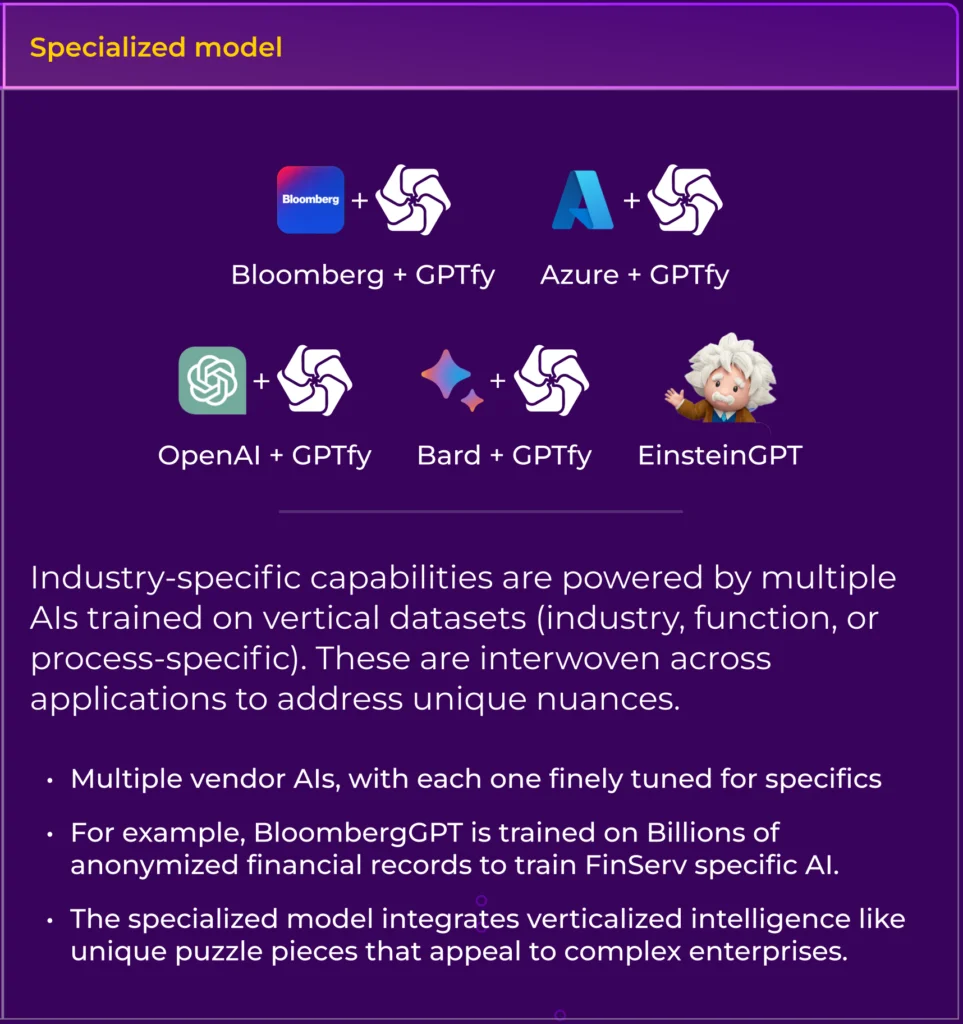Bring Your Own AI Model for Salesforce with GPTfy
What?
A plain English guide to ‘Bring Your Own AI Model/LLM’ (BYOM/BYOK) with Salesforce.
Who?
Salesforce Admins, Developers, Architects, Product Owners, CRM Business Analysts, and anyone else who is engaged in bringing AI to their Salesforce platform.
Why?
Enable AI Choices. Pick the right Model for the job. Reduce Costs.
What Can You Do With It?
Pick different AI Models: Use whatever LLM best meets your business, technical, regulatory and data security needs.
Your business is unique. You have specific goals, challenges, and opportunities that set you apart from your competitors.
But how do you leverage the power of AI to achieve your objectives and overcome your obstacles?
You don’t have to settle for a one-size-fits-all AI model anymore.
With BYOM, you can choose and integrate AI models from the leading providers in the industry, such as OpenAI, Google Cloud, Dialogflow, Cohere, Azure, AWS, and Anthropic, into your existing software platforms. It’s like upgrading your car with a new, state-of-the-art engine that can take you further and faster.
Common Reasons for BYOM
Customization and Specialization
Tailored or Vertical AI solutions are developed to meet unique business needs, offering industry-specific insights. This approach allows business units to create models tuned for their specific needs and data.
Use Case: A retail company predicts stock levels based on seasonal trends. Additionally, a marketing team uses a predictive lead scoring model to prioritize customer outreach.
Other Considerations: Flexibility, domain expertise, competitive advantage.
Industry Specific or Vertical AI Models

Data Privacy and Security
Keeping sensitive data in-house to comply with regulations and protect intellectual property, avoiding third-party AI service providers.
Use Case: A healthcare organization ensures HIPAA compliance with patient data analysis. An InfoSec team uses a model to analyze firewall log data for security threats.
Other Considerations: GDPR, HIPAA, data breach, InfoSec, cybersecurity, privacy, legal compliance.

Integration and Compatibility
Seamless integration with existing systems and workflows, offering flexibility in deployment environments. Models are designed for smooth integration.
Use Case: A custom AI model enhances Salesforce CRM capabilities. Another model is built within a specific business rules engine for automated decision-making.
Other Considerations: Legacy systems, cloud deployment, lock-in avoidance, interoperability.

Cost Efficiency
Avoiding ongoing fees of third-party services and optimizing operational costs by tailoring models to specific use cases and infrastructure.
Use Case: A manufacturing firm uses BYOM for predictive maintenance, significantly reducing downtime and maintenance costs.
Other Considerations: Operational efficiency, resource optimization.
Innovation and Continuous Improvement
Rapid iteration of models to incorporate new data and feedback, owning the intellectual property generated.
Use Case: A fintech startup continuously evolves its fraud detection model to adapt to emerging fraud patterns. A tech company develops a new retention model every sprint to respond to business or feature changes.
Other Considerations: Intellectual property, rapid iteration, fintech, time-to-value, responsiveness.

Agility
Faster experimentation cycles for teams to build models tailored to changing business conditions.
Use Case: Teams across different departments develop new models every sprint to respond to business or feature changes, ensuring agility in product development and customer service.
Other Considerations: Time-to-value, responsiveness.
Control
More control and autonomy over AI/ML impacts, ensuring governance, accountability, and transparency.
Use Case: A research team controls an experimental NLP model for analyzing complex reports and documents.
Other Considerations: Governance, accountability, transparency.
Industry Specific or Vertical AI Models

Accountability
Teams own the performance of their models, ensuring alignment with business goals and performance metrics.
Use Case: An eCommerce team tunes a recommendation engine to improve customer engagement and sales conversions.
Other Considerations: Performance metrics, MLOps.
IP Protection
Ensures teams retain IP rights and privacy for proprietary data, which is crucial for legal compliance and maintaining a competitive edge.
Use Case: A software company develops a proprietary algorithm for real-time data encryption, enhancing product security while retaining IP rights.
Other Considerations: Cybersecurity, privacy, legal compliance, proprietary technology.
Your BYOM, ready in a few clicks.
Custom AI Response Flow
Here’s how it works:
-
Choose Your Model
Dive into GPTfy’s Cockpit and pick the ‘Create your own’ card. This is where your journey to customized intelligence begins. -
Customize It
Give your model a name, an icon, and a brief description. This step ensures your AI model resonates with your specific Salesforce needs. -
Set It Up
Add the nitty-gritty—platform details named credentials and tweak settings like Top P and Temperature to get the right response behavior. -
Activate
Your model goes live with a click, ready to deliver custom AI responses directly within your Salesforce platform.
Conclusion
GPTfy allows you to build and customize your own AI models to fit your specific needs, offering control, data privacy, cost-efficiency, and other benefits.
Ready to transform how you engage, automate, and innovate?
Let’s make it happen with GPTfy.